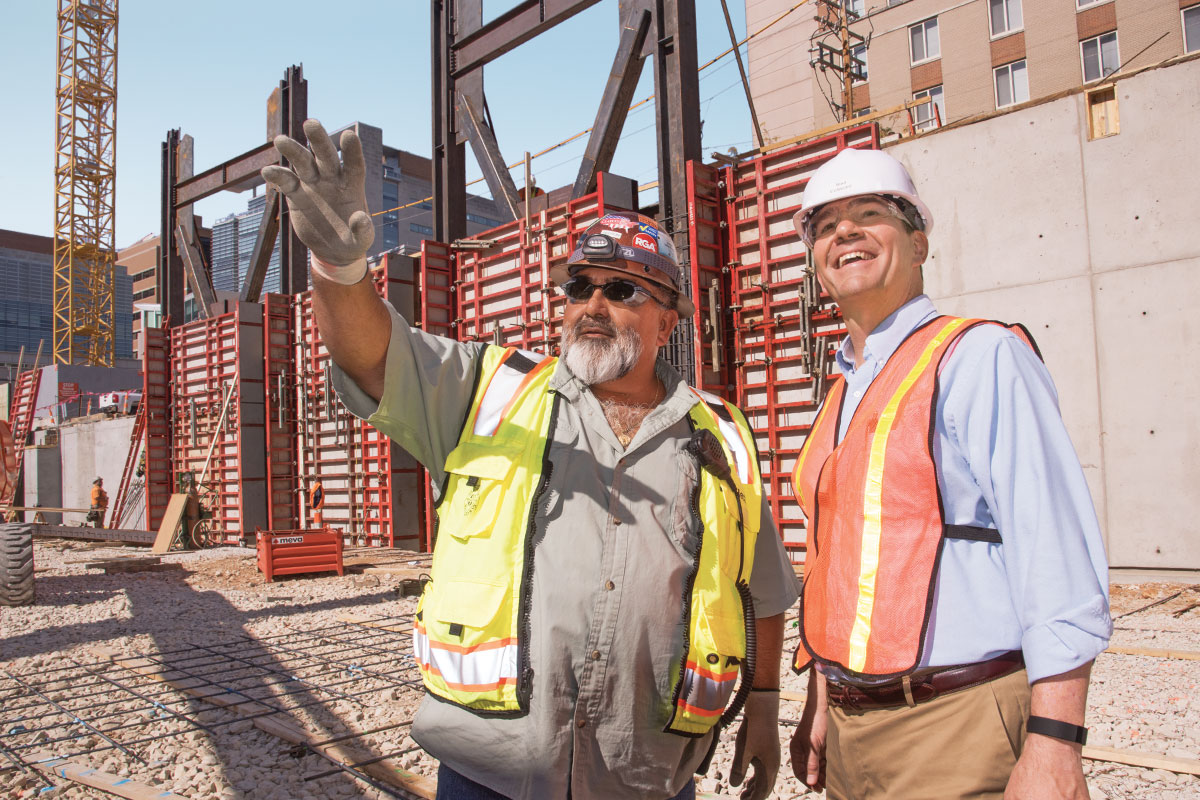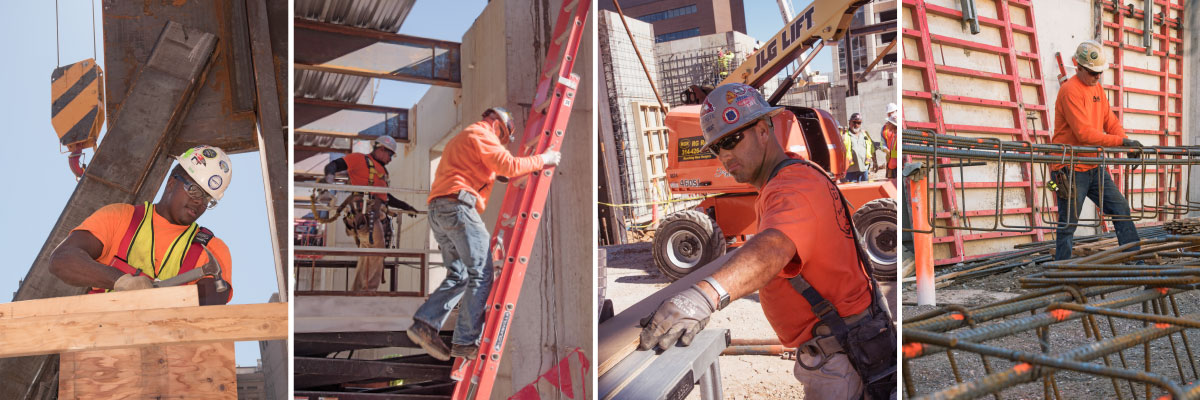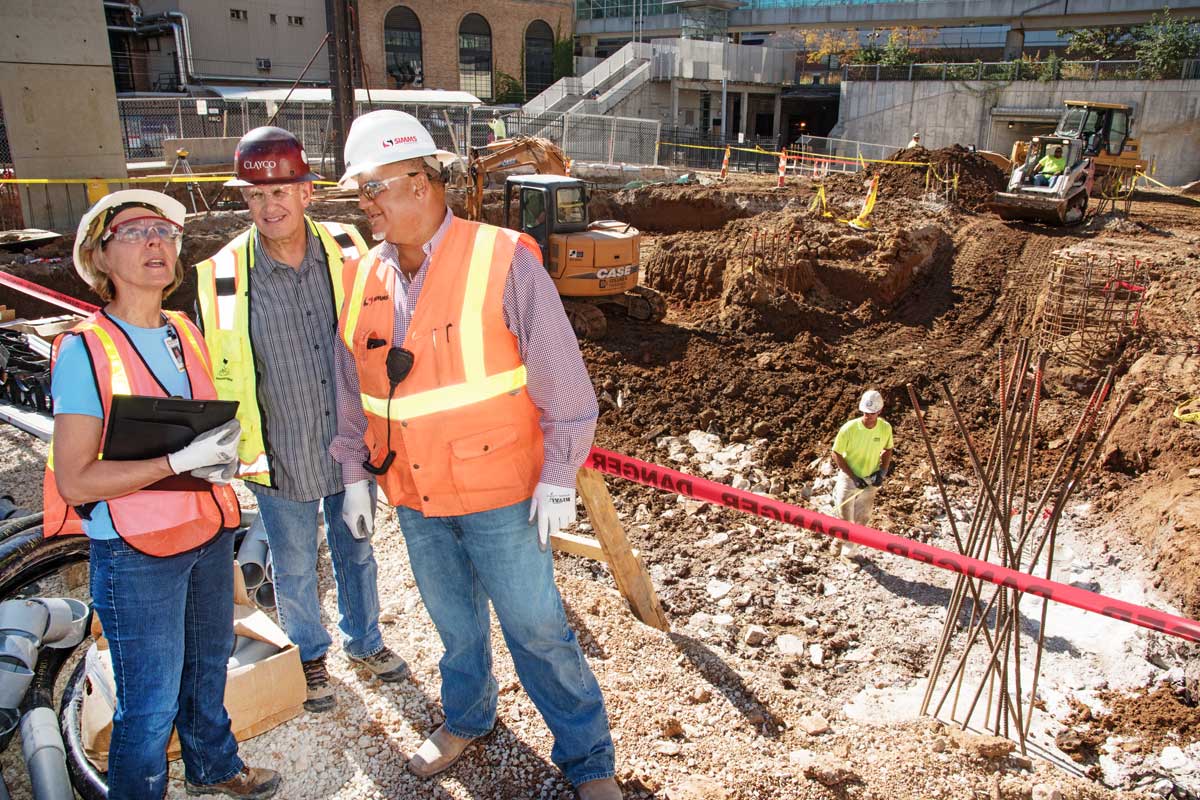
At the Mid-Campus Center construction site, Hector Lozoya, senior safety engineer for Clayco, discusses progress with occupational health researcher Brad Evanoff, MD.
SUCK IT UP. When it comes to chronic injuries, that’s been the mantra in the macho, male-dominated, highly competitive culture of commercial construction. However, industry experts and younger generations of construction workers are realizing that attitudes and behaviors must change for safety to improve.
The sector has made major strides in reducing acute injuries from construction-site accidents. Less attention has been placed on preventing musculoskeletal injuries caused by force, repetition, awkward posture and overexertion. The costs are great, both to the company and the individual.
Such injuries make workers less effective, potentially more dangerous, and often result in prolonged absences and early retirement.
Is it possible to modify these physically demanding jobs? And, if so, what’s the most effective way to reach millions of front-line workers?
As it turns out, St. Louis is the perfect backdrop to find the answers; it is home not only to offices of the safety-conscious Clayco, a national innovator in the design-build industry, but also to School of Medicine occupational health experts who are among a handful of researchers worldwide dedicated to measuring and improving the safety climate in construction.
Together, the medical school team and Clayco won a $1 million, five-year grant from the National Institute of Occupational Safety and Health and the CPWR Center for Construction Research and Training. Through this, an on-campus building project is serving as a research lab of a different sort.
Now, as tradespeople labor on Mid-Campus Center, an administrative building for the medical school and Barnes-Jewish and St. Louis Children’s hospitals, the researchers methodically observe. The hope is that the resulting recommendations will be adopted into construction safety management systems around the country.
Headed by Bradley A. Evanoff, MD, the Richard A. and Elizabeth Henby Sutter Professor of Occupational, Industrial and Environmental Medicine and director of the Division of General Medical Sciences, the team conducts research on improving health and decreasing disability among working populations.
The goal: National impact in construction safety
Over the past 20 years, the researchers have embarked on a wide range of studies: smoking cessation among blue-collar workers; carpal tunnel syndrome; welding exposures; back injuries in health-care professionals; and obesity intervention programs in the workplace. These community-based studies often have involved recruiting large numbers of employees and cooperating closely with employers and labor unions.
One such study focused on fall prevention in residential construction. The team’s Vicki Kaskutas, OTR/L, OTD, helped the St. Louis Carpenters Joint Apprenticeship Program improve training, adding a mock house showcasing safety equipment and a dummy to demonstrate fall arrest gear. (Later, the Occupational Health and Safety Administration hailed Kaskutas’ website cataloguing 150 fall prevention devices as the most comprehensive resource of its type.) John Gaal, EdD, of the Carpenters’ District Council of Greater St. Louis & Vicinity, said that the house mock-up and its fall demonstrations became “the world model to teach fall protection.” He added: “Until you have a tier-one institution like Washington University doing this research, industry won’t listen. There is no doubt that we are safer now.”
Eventually, researchers turned their attention to commercial construction workers, who face myriad risks in ever-changing, complex environments.
 Robert Boston
Robert Boston
A deadly four, plus one
Years ago, OSHA identified the four leading causes of fatalities in construction. These are known as the Focus Four: electrical, struck-by, caught-in-between and falls.
An OSHA training course educates workers on how to avoid such dangers, and these four categories are the primary focus during federal inspections of construction sites. Because of sustained attention at multiple organizational levels, these hazards have been significantly reduced.
However, musculoskeletal injuries — low back pain, knee injuries, tendonitis, torn rotator cuffs and carpal tunnel syndrome — remain commonplace. Many construction-related tasks push the human body beyond its natural limits as workers lift heavy materials, hold vibrating equipment, apply force, bend, kneel, twist, grip and reach overhead.
School of Medicine researchers suggest adding one more important area of emphasis: ergonomics.
The challenge: Construction work pushes the human body to its limits, and beyond
The science of ergonomics examines the relation between workers and their environments. This approach identifies uncomfortable or difficult tasks and seeks practical, adaptive solutions for improvement. The goal is to make sure workers stay safe, comfortable and productive.
Traditionally, ergonomics programs have been viewed as an add-on to safety programs, lacking the management support and commitment necessary to bring about changes in behavior and work design.
“Reducing chronic injuries has taken a backseat to acute injuries,” Evanoff said. “For good reason. Acute injuries cause many fatalities. Chronic injuries are just accepted as part of the job. We want to know — are there ways to keep productivity up, without beating the body up in the process? Can we do a better job of affecting chronic disease?”
The individual worker
In earlier studies, principal investigator Ann Marie Dale, PhD, research assistant professor of medicine and occupational therapy, learned that individual construction workers, while willing to adapt, lacked the power to change the culture.
Over a five-year period, the team worked with seven different subcontractors on job sites. There, they observed sheet metal workers, floor layers, carpenters and other tradespeople in action, photographed their activities and engaged in dialogue. Each week, Dale participated in “toolbox talks” to discuss improving ergonomics. The team also created sets of laminated safety cards. Bound to carabineers for quick, easy access, these card sets gave tips on how to lift properly, minimize vibration and choose hand tools.
As Dale built trust within St. Louis construction trades, she began evaluating the effectiveness of participatory ergonomics — leveraging worker experience to identify and correct factors that negatively affect health. After training, workers improved the safety and healthfulness of their work by trying new tools and changing the way they performed tasks. For example, floor layers proposed using an extended handle on spray cans to reduce the time spent kneeling. Dale also realized that a construction worker is more likely to invest in a safer hand tool than a subcontractor is to purchase a safety device or service a lift to keep it operating safely.
In a remodeling project, workers were removing old carpet from classrooms. Sometimes workers pulled carpet by hand; other times they used an automatic puller. The device required significantly less hand force, but, as several workers were performing this task at different sites, its availability depended upon coordination with management.
“What we found is that construction workers don’t have enough control over their environment,” said Dale, who is triple-certified in ergonomics, occupational therapy and hand therapy. She realized she needed to go higher in the organization.
“Workers made changes, but not enough to reduce symptoms. Giving knowledge is not enough. Construction managers such as Clayco define the safety of the workplace. They can require safe practices from their subcontractors, so they can have the greatest influence on worker safety.”
 Robert Boston photos
Robert Boston photos
The system level
About the same time Dale was working to secure grant funding for a project involving a construction manager, Clayco was looking for ways to better integrate ergonomics into its safety program. “Clayco recently added overexertion as it fifth focus area, but, as a company, we hadn’t yet put structure around it,” said Todd Friis, vice president of risk management at Clayco, who regularly conducts safety audits at about 30 job sites across the country.
The team now is studying how the safety climate set by a construction manager affects the behavior and attitudes of subcontractors and their employees. “We know that some subcontractors improve their safety procedures to qualify for work with safety-conscious construction managers,” Dale said. “We’re trying to see if such changes persist and how they happen, and whether the safety requirements of the larger construction managers help shape the regional safety culture among smaller contractors.”
Team members regularly visit the Mid-Campus Center site, recording current practices and assessing safety knowledge among workers.
Walking about the site, Dale makes comments: “That piece of equipment is too heavy for that worker. If that task was being performed at waist-level instead of on the ground, he wouldn’t have to strain so much.”
“We are giving them our eyes … what’s good and bad related to ergonomics,” Dale added. “Our role is to build into their safety program so they can use that knowledge every day.”
The change: Reducing risk requires a deep understanding of the work that can only come from the workers
Researchers attend the morning huddles, which include a mix of safety information and warm-up exercises. “The huddles set the tone,” Friis explained. “Every day we ask, ‘What are the risks today based on my scope of work? What do I need to mitigate?’”
Remaining cognizant of tight production schedules, the research team is gaining information from the workers, both through on-site interaction and surveys.
“The survey questions are clever,” Friis said. “One question asks whether the worker has ever been hurt by overexertion. And, of course, most answer no. Another question asks whether a partner or buddy has ever been injured. And, of course, they all answer yes. They may not say it about themselves, but they’ll say it about a buddy … injuries that, up until now, haven’t come to the surface.”
Direct feedback from workers is crucial, Evanoff said. “It’s truly been a participatory model. We can come in and see hazards, but to make changes, we need the day-to-day collaboration. They’re the ones with the deep knowledge. Describing the risk factors, in retrospect, is the easy part. How to reduce risk factors in a complicated, dangerous, dynamic environment — that’s the tough part. It takes a deep understanding of what the work is like.”
Researchers also participate in Clayco’s weekly planning meeting, talking through the next phases of construction. Their questions are specific: How are you going to transport that rebar? How are workers lifting those panels? Ergonomics is about anticipating all the steps and putting the best tools and equipment in place beforehand.
In addition, the researchers are reviewing Clayco’s monthly safety dashboards, which list total reported injuries and their causes. “It’s full disclosure,” Friis said. “It’s like looking in our sock drawer.”

Onsite dialogue and observation have proven critical for understanding the constantly changing construction environment. Ann Marie Dale, PhD, queries Bob Hohman and Scott Sams.
A model to emulate
In the end, the researchers will propose ideas to benefit workers and help eliminate soft-tissue injuries. Clayco will decide which changes to adopt as part of an enhanced safety and ergonomics program.
“In the next months, this will move from observation to tactical implementation,” Friis said. “That’s been the real differentiator here. This isn’t someone sitting at a computer running reports, but researchers who are interacting in the field.”
Friis credits Dale as someone with “the right skill level and temperament to work with our guys. She has spent a lot of time in the field and it comes across.”
Dale, co-chair of the building and construction committee for the International Ergonomics Association, travels globally to network and share knowledge with a small niche of likeminded researchers.
“For Clayco, it’s been great to partner with such passionate people as we consider how to enhance our program,” Friis said. “The enthusiasm rubs off on our guys. And it keeps them on their toes. Here are people with PhDs evaluating and assessing our programs.”
“All the guys are talking about it,” said Hector Lozoya, Clayco senior safety engineer. “It will be very interesting to see what they find, what their recommendations are and how it will affect productivity. Are big companies willing to make the changes?”
Recently, Clayco CEO Bob Clark temporarily halted operations at the site when he spotted something he thought was unsafe.
Lozoya recalled: “Some of the guys were worried about deadlines and kind of grumbling. I said, ‘Let’s not look at it that way. You are working for an owner that’s concerned about your safety. Everyone’s going to go home at the end of the day.’”
Ultimately, new protocols could be developed in many key areas, such as orientation and training, written policies, signage, bidding procedures and inspection forms. A year after the changes, the researchers plan to come back, survey workers and make comparisons.
The goal is to create a program that exerts influence regionally and nationally. “Obviously, we have to get buy-in from all levels — owner to worker — so safety and ergonomics are incorporated into every aspect of the process and simply become the way we do business,” Friis said.
“Really, our interest is the whole industry,” he added. “We want to go big with this. This is a significant opportunity to transform the industry.”
Published in the Winter 2015-16 issue


